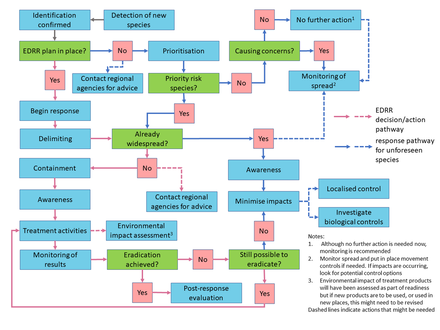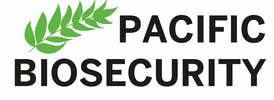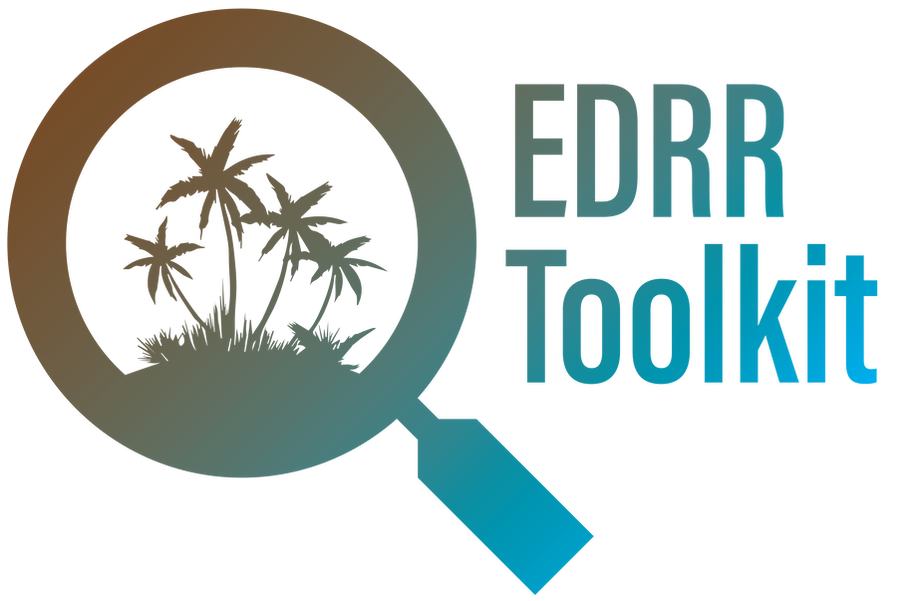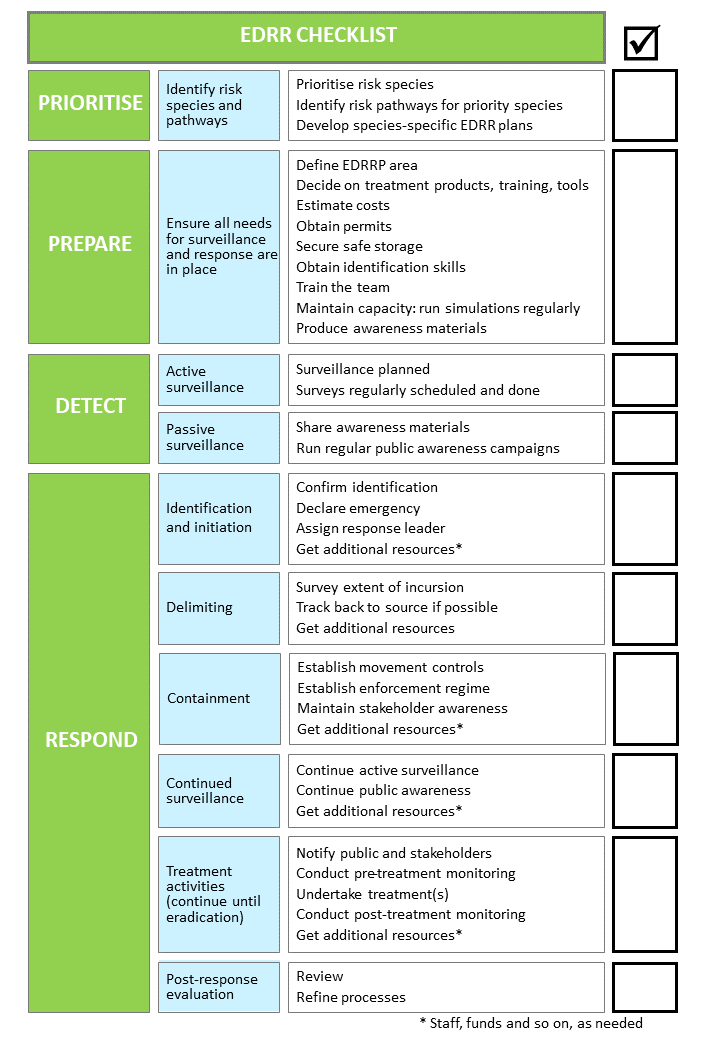|
This is a work-in-progress collection of resources to support EDRR for priority invasive species, primarily of environmental concern, in the Pacific.
You can use these resources to develop an EDRR programme for a single species or many species, at a single site or countrywide, only for international biosecurity, only for domestic biosecurity, or for both. Or just use the resources, like the factsheets, for reference. It all depends on what you need. What is an EDRR programme? Early Detection and Rapid Response (EDRR) is an approach (or system) to give you a better chance of eradicating a newly arriving, potential harmful species before it establishes and spreads, and while eradication is still possible. The actions needed can be summarised most simply as "prioritise, prepare, detect, respond". The development and implementation of an EDRR programme follows the steps outlined in the EDRR checklist (also shown on the left). The checklist is based on a review of regional and international EDRR plans and represents a consensus. Other sources of information on EDRR might use different terms, or emphasise different aspects, but the goal is the same: to detect a newly arriving species in time for it to be eradicated, and before it spreads too far and has caused a great deal of harm. These resources are a work-in-progress, so we welcome suggestions on how they could be developed further. If an unwanted invasive species arrives in your country and you don't have a plan for how to deal with it, contact PRISMSS support. Introductory reading If you are not familiar with biosecurity for invasive species in the Pacific, or what EDRR is and how the concept is similar to but differs from emergency response (also called incursion response), you can read these two Battler Guides available from SPREP as a first step. Protect our islands with biosecurity This guide outlines biosecurity principles and practice for Pacific island countries and territories, and describes how EDRR fits in with biosecurity. The focus of this approach is on domestic biosecurity and it does not replace agreed best practice for international biosecurity. Catch it early: Invasive species Early Detection and Rapid Response The EDRR Battler Guide gets into a little more detail, but is still at a high enough level for you to not get overwhelmed. |
The EDRR template
This EDRR template is intended to provide a framework for you to develop an EDRR programme (or framework) for your country. It is also intended to meet the requirements of an emergency response plan according to Biosecurity Model Law that was developed for the Pacific in around 2007. Many Pacific countries have used this Biosecurity Model Law as a basis for their own Biosecurity Acts.
To be effective, any international biosecurity emergency response plan (ERP) or EDRR plan must be consistent with the country’s legal mandate. If a response plan is being developed for domestic use (for example, to reduce the risk of an invasive species establishing on a new island), local regulations will need to be consulted.
If you’d like some assistance completing the template, please get in touch. And remember, you can change the template however you need to depending on your situation. Our EDRR resources are provided as an aid, not a mandate. Examples of different plans and other templates are provided at the foot of the page. Use what works best for your situation.
EDRR requires commitment to surveillance. To be effective, EDRR needs to be supported by the commitment to undertake surveillance for the target species. This is what is assumed in the EDRR programme outlined in the template.
Without surveillance (or monitoring) for the species, the risk of the species arriving and establishing is higher than with surveillance, because you are unlikely to "catch it early".
But if you are not yet ready or able to commit the time and resources needed for surveillance, you can still use the template to develop an emergency response plan for invasive species. Or you can use the generalised SPC emergency response plan and tailor that to your needs, or one of the other examples provided.
You'll find links at the bottom of the page to a range of existing response plans that could be helpful. There is not a "one-size-fits-all" solution.
EDRR resources
The EDRR resources outlined here are intended to help fulfil the requirements of checklist described above. The resources support the implementation of EDRR for some of the highest priority invasive plants and animals. The EDRR Toolkit protocols (below) were derived from existing resources for target species (where they were available). The goal is to collate protocols for priority species over time. In the meantime, if you need more information, please contact PRISMSS support.
All the protocol documents have source attributions included (where they came from/who wrote them), and it is important that these attributions are retained if the information is used elsewhere. This is to ensure that Intellectual Property/copyright considerations are respected.
If the species you want information for is not in the list below please contact PRISMSS support.
Templates for reports of potential newly arriving invasive species
EDRR protocols and resources for priority species
See the factsheets page for information on awareness and identification resources for the priority species and species groups.
This EDRR template is intended to provide a framework for you to develop an EDRR programme (or framework) for your country. It is also intended to meet the requirements of an emergency response plan according to Biosecurity Model Law that was developed for the Pacific in around 2007. Many Pacific countries have used this Biosecurity Model Law as a basis for their own Biosecurity Acts.
To be effective, any international biosecurity emergency response plan (ERP) or EDRR plan must be consistent with the country’s legal mandate. If a response plan is being developed for domestic use (for example, to reduce the risk of an invasive species establishing on a new island), local regulations will need to be consulted.
If you’d like some assistance completing the template, please get in touch. And remember, you can change the template however you need to depending on your situation. Our EDRR resources are provided as an aid, not a mandate. Examples of different plans and other templates are provided at the foot of the page. Use what works best for your situation.
EDRR requires commitment to surveillance. To be effective, EDRR needs to be supported by the commitment to undertake surveillance for the target species. This is what is assumed in the EDRR programme outlined in the template.
Without surveillance (or monitoring) for the species, the risk of the species arriving and establishing is higher than with surveillance, because you are unlikely to "catch it early".
But if you are not yet ready or able to commit the time and resources needed for surveillance, you can still use the template to develop an emergency response plan for invasive species. Or you can use the generalised SPC emergency response plan and tailor that to your needs, or one of the other examples provided.
You'll find links at the bottom of the page to a range of existing response plans that could be helpful. There is not a "one-size-fits-all" solution.
EDRR resources
The EDRR resources outlined here are intended to help fulfil the requirements of checklist described above. The resources support the implementation of EDRR for some of the highest priority invasive plants and animals. The EDRR Toolkit protocols (below) were derived from existing resources for target species (where they were available). The goal is to collate protocols for priority species over time. In the meantime, if you need more information, please contact PRISMSS support.
All the protocol documents have source attributions included (where they came from/who wrote them), and it is important that these attributions are retained if the information is used elsewhere. This is to ensure that Intellectual Property/copyright considerations are respected.
If the species you want information for is not in the list below please contact PRISMSS support.
Templates for reports of potential newly arriving invasive species
- Report template (to be shared widely in an awareness program so that people report useful information.
- Recording template (for recording reports of invasive species).
EDRR protocols and resources for priority species
See the factsheets page for information on awareness and identification resources for the priority species and species groups.
Species (or higher level group of species) |
Protect our Islands EDRR Toolkit protocols (surveillance and rapid response) |
Online resources (including identification, surveillance, control, eradication and monitoring) |
|
Ants |
Pacific Invasive Ant Toolkit (management of several species) Pacific Invasive Ant Key (identifications) Hawai'i Ant Lab (Little fire ant management and images of invasive ants found in many Pacific countries) CABI also has information on many ant species USDA Imported Fire Ant Manual |
||
Birds |
|
Contact PRISMSS Predator Free Pacific programme |
CABI (Common myna and Red-vented bulbul) All about birds website (Eurasian tree sparrow and House sparrow) PestSMART (pest birds) |
Cane toad (and other amphibians) |
16 MB download. Developed by James Reardon of the New Zealand Department of Conservation. Other resources on the right |
CABI (Cane toad) PestSMART (Cane toad) Trapping Cane toads using the Super Trap ANZCCART humane methods for killing Cane toads |
|
Coconut rhinoceros beetle (CRB) |
None planned - contact SPC through your National Plant Protection Officer |
SPC CRB control and management guidelines CRB field guide (Plant heroes) CRB at CABI CRB at Coconut Pests and Diseases Toolkit (other coconut pests also) CRB at Pacific Pests, Pathogens and Weeds |
|
Giant African snail (GAS) |
|||
Marine and aquatic species |
Contact PRISMSS |
Pacific Marine Biosecurity Toolkit Manage marine biosecurity in the Pacific Battler Guide CABI (see factsheets for links or search on CABI for species names) PestSMART (Tilapia) |
|
Mongoose |
CABI (see factsheets for links or search on CABI for species names) |
||
Snakes, lizards and other reptiles |
|
CABI (see factsheets for links or search on CABI for species names) Brown treesnake Rapid Response Team |
|
Rodents (rats and mice) |
3 MB download. Derived from the sources on the right Also contact PRISMSS Predator Free Pacific programme |
||
Wasps |
Contact PRISMSS |
CABI (see factsheets for links or search on CABI for species names) |
|
Weeds |
Manage low-incidence priority weeds to protect biodiversity in the Pacific Battler Guide Weeds reported in the Pacific (NENS) click on search without entering any information to get the full list of weeds in all countries Pacific Pests, Pathogens and Weeds DoC Weeds SOPS CABI (see factsheets for links or search on CABI for species names) |
||
Fall army worm (FAW) |
None planned. Factsheet available. Contact SPC |

The response
Sometimes when a new species arrives unexpectedly it is difficult to know where to start. The action and decision pathway on the left (click for a larger pdf version) helps you decide what you need to do. This can be used together with the checklist.
Note that the pathway differs if the new species is one that was identified as a risk and you already have an EDRR plan in place for it (pink arrows). The decision pathway is much simpler.
But if you don't have a plan in place, or the species is unexpected, this simplified response action pathway can be used as a guide.
Sometimes when a new species arrives unexpectedly it is difficult to know where to start. The action and decision pathway on the left (click for a larger pdf version) helps you decide what you need to do. This can be used together with the checklist.
Note that the pathway differs if the new species is one that was identified as a risk and you already have an EDRR plan in place for it (pink arrows). The decision pathway is much simpler.
But if you don't have a plan in place, or the species is unexpected, this simplified response action pathway can be used as a guide.
Example EDRR plans, templates and other resources
There is more than one way to approach EDRR, and you can make use of existing resources to fit your needs. Contact PRISMSS support for assistance.
- SPC general emergency response plan 2001 (pdf) (word)
- SPC general emergency response plan for invasive ant incursions (pdf) (word)
- Invasive species early detection and rapid response plan for British Columbia
- Emergency Response Plan for Coconut Rhinoceros Beetle in Pohnpei
- Cook Islands invasive species early detection and rapid response plan
- A surveillance and rapid response plan for priority invasive species in Kiribati
- Kiribati Biosecurity Emergency Response Plan
- Emergency Response Plan for invasive ant incursions for Federated States of Micronesia (on request from Casper Vanderwoude, Hawai'i Ant Lab, University of Hawai'i)
- Emergency Response Plan for ants in Palau (on request from Casper Vanderwoude, Hawai'i Ant Lab, University of Hawai'i)
- Biosecurity Plan for Ouvea Atoll, Loyalty Islands, New Caledonia (has information on response as well as general biosecurity)
- Plant Pest Surveillance: A guide to understand the principal requirements of surveillance programmes for national plant protection organizations
- Monitoring guide to detect new non-native plant species (UK Overseas Territories)
- New Zealand Department of Conservation Weeds Standard Operating Procedures
General biosecurity and invasive species management resources




